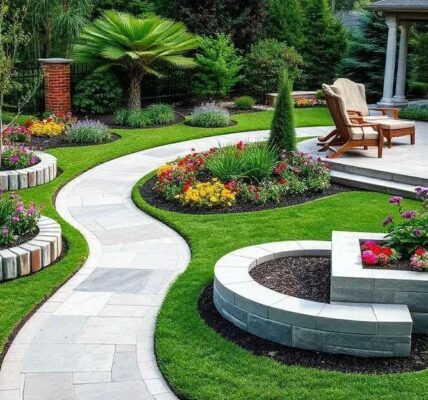In recent years, home gardening has blossomed into a popular hobby for people of all ages. Whether you’re cultivating a small urban balcony or a sprawling backyard, gardening offers numerous benefits. Not only does it provide a sense of accomplishment, but it also contributes to mental well-being and promotes sustainable living. As more people seek ways to connect with nature and enhance their living spaces, the demand for innovative and practical gardening ideas continues to grow.
This article explores various home gardening ideas tailored to different spaces and needs. From small apartment balconies to larger yards, you’ll discover creative ways to turn any area into a thriving garden. Whether you’re an experienced gardener or just starting, these ideas will help you cultivate a green space that brings joy and freshness to your home.
Benefits of Home Gardening
Enhances Mental Well-being
Gardening is more than just a hobby; it’s a therapeutic activity that can significantly improve mental health. Spending time nurturing plants has been shown to reduce stress, anxiety, and depression. The simple act of tending to a garden allows you to disconnect from the digital world and reconnect with nature, providing a calming and meditative experience. The satisfaction of watching your plants grow and thrive contributes to a sense of purpose and fulfillment.
Provides Fresh and Organic Produce
One of the most rewarding aspects of home gardening is the ability to grow your own fresh, organic produce. Whether it’s a few pots of herbs or a full-fledged vegetable garden, having access to homegrown food ensures that you’re consuming fresh and pesticide-free ingredients. This not only enhances the flavor of your meals but also supports a healthier lifestyle. Additionally, gardening reduces the carbon footprint associated with transporting store-bought produce.
Encourages Sustainable Living
Home gardening is a step towards sustainable living. By growing your own food and using eco-friendly gardening practices, you contribute to the conservation of resources and reduce waste. Gardening allows you to recycle organic materials, such as kitchen scraps, into compost, which enriches the soil and reduces the need for chemical fertilizers. Additionally, planting native species and using water-efficient methods like drip irrigation help conserve water and promote a healthier ecosystem.
Small Space Gardening Ideas
Vertical Gardening Solutions
When space is limited, vertical gardening offers an excellent solution to maximize your growing area. By utilizing vertical space, you can create a lush garden even in the smallest of spaces. Wall planters, hanging pots, and trellises are popular options for vertical gardening. These structures allow you to grow a variety of plants, from flowering vines to fresh vegetables, without taking up precious floor space. Vertical gardens not only add greenery but also serve as a beautiful focal point in your home.
Container Gardening
Container gardening is another versatile approach to small space gardening. It involves growing plants in pots or containers, which can be placed on balconies, patios, or even indoors. The key to successful container gardening is selecting the right plants and containers. Herbs, small vegetables like cherry tomatoes, and ornamental plants thrive in containers. Additionally, you can easily move containers around to catch the best sunlight or rearrange them to refresh the look of your space. Container gardening allows you to enjoy the beauty and benefits of gardening without the need for a large yard.
[content-egg-block template=offers_grid]
Herb Gardens in the Kitchen
For those with limited outdoor space, growing an herb garden in the kitchen is a practical and rewarding idea. Herbs such as basil, parsley, and mint can be grown on windowsills, countertops, or in small hanging baskets. Not only do they add a touch of greenery to your kitchen, but they also provide fresh, flavorful ingredients for your cooking. Herb gardens are low-maintenance and can thrive with just a little sunlight and regular watering, making them ideal for both seasoned gardeners and beginners alike.
Balcony and Patio Gardening
Choosing the Right Plants
Balconies and patios present unique gardening opportunities, but they also come with challenges such as limited sunlight and space. To make the most of your balcony or patio garden, it’s essential to choose plants that are well-suited to these conditions. Shade-tolerant plants like ferns, hostas, and begonias can thrive in areas with limited direct sunlight. Additionally, consider plants that grow well in containers, such as petunias, geraniums, and dwarf fruit trees. With the right plant selection, you can transform your balcony or patio into a vibrant and inviting garden oasis.

Creating a Relaxing Outdoor Space
Your balcony or patio garden can be more than just a place for plants; it can also serve as a peaceful retreat where you can unwind and enjoy the outdoors. To create a relaxing outdoor space, consider adding comfortable seating, soft lighting, and decorative elements like cushions, rugs, and lanterns. Incorporate plants that add fragrance and color, such as lavender or jasmine, to enhance the ambiance. By thoughtfully designing your balcony or patio, you can create a garden that is both functional and aesthetically pleasing, providing a perfect escape from the hustle and bustle of daily life.
DIY Garden Projects for Balconies
DIY garden projects are a fun and creative way to personalize your balcony garden while making the most of the space you have. Upcycling materials, such as old pallets, crates, or tin cans, into planters and garden accessories is both eco-friendly and cost-effective. You can also build vertical garden frames or hanging baskets using simple tools and materials. These DIY projects not only add character to your garden but also allow you to create custom solutions that suit your space and style perfectly.
Indoor Gardening Ideas
Best Indoor Plants for Clean Air
Indoor gardening not only beautifies your home but also improves air quality. Certain plants are particularly effective at filtering out toxins and purifying the air. Some of the best air-purifying plants include the snake plant, spider plant, and peace lily. These plants are not only attractive but also low-maintenance, making them perfect for indoor environments. By strategically placing these plants around your home, you can create a healthier living space while enjoying the calming presence of greenery.
Setting Up a Home Greenhouse
For those who are passionate about gardening and want to extend their growing season, setting up a home greenhouse can be a rewarding project. Mini-greenhouses or plant terrariums are ideal for indoor use and can be placed on a sunny windowsill or in a bright room. These small greenhouses create a controlled environment where plants can thrive year-round. Whether you’re growing tropical plants, starting seeds, or cultivating succulents, a home greenhouse provides the perfect conditions for your plants to flourish.
Hydroponic Gardening at Home
Hydroponic gardening is a soil-free method of growing plants that can be easily adapted for indoor spaces. This system uses a nutrient-rich water solution to nourish plants, making it possible to grow a variety of vegetables, herbs, and even fruits indoors. Hydroponic setups can range from simple DIY systems to more advanced, automated systems. The benefits of hydroponic gardening include faster plant growth, higher yields, and the ability to garden year-round. It’s an innovative and efficient way to enjoy fresh produce right from your home.
Gardening for Larger Yards
Raised Bed Gardening
For those with more space, raised bed gardening offers a versatile and efficient way to grow a wide variety of plants. Raised beds improve soil drainage, reduce the risk of soil compaction, and make it easier to manage weeds. They are also accessible for people with limited mobility, as they reduce the need for bending and kneeling. When planning a raised bed garden, consider the size, location, and materials. Raised beds can be constructed from wood, stone, or recycled materials, and can be customized to fit the layout of your yard. This method is perfect for growing vegetables, flowers, and even small shrubs.
Themed Garden Spaces
Creating themed garden spaces in larger yards allows you to explore different gardening styles and cater to specific interests. For example, a butterfly garden filled with nectar-rich plants like milkweed, coneflowers, and lantanas can attract butterflies and other pollinators. A vegetable patch, on the other hand, can be dedicated to growing your favorite seasonal produce. Other popular themes include herb gardens, sensory gardens with fragrant plants, and ornamental flower beds. Themed gardens add character to your yard and provide a focused approach to your gardening efforts.
Water Features in Gardens
Adding a water feature to your garden can transform it into a tranquil oasis. Water features, such as ponds, fountains, or bird baths, not only enhance the aesthetic appeal of your garden but also attract wildlife like birds and beneficial insects. Ponds can be stocked with aquatic plants and fish, creating a self-sustaining ecosystem. Fountains, with their soothing sounds, can mask unwanted noise and create a peaceful atmosphere. Whether you have a small corner or a large area, a water feature can add an element of serenity and natural beauty to your garden.
Sustainable Gardening Practices
Composting at Home
Composting is an essential practice for sustainable gardening. It involves recycling organic waste, such as kitchen scraps, yard clippings, and fallen leaves, into nutrient-rich compost that can be used to enrich your garden soil. Starting a compost pile or using a compost bin at home is simple and requires minimal effort. The resulting compost improves soil structure, enhances water retention, and provides essential nutrients to plants, reducing the need for chemical fertilizers. Composting is an eco-friendly way to reduce waste and support a healthy, thriving garden.
Water Conservation Techniques
Water is a precious resource, and conserving it should be a priority in any garden. There are several water conservation techniques that can be easily implemented in your home garden. Rainwater harvesting, for example, involves collecting rainwater from roofs or gutters and storing it for later use in the garden. Drip irrigation systems are another effective method, delivering water directly to the plant roots with minimal waste. Mulching your garden beds helps retain soil moisture, reducing the need for frequent watering. By adopting these practices, you can maintain a lush garden while minimizing water usage.
Organic Pest Control Methods
Maintaining a healthy garden often involves managing pests, but this doesn’t mean resorting to harmful chemicals. Organic pest control methods are safer for both your plants and the environment. Companion planting, for example, involves growing certain plants together to naturally repel pests. Marigolds, for instance, can deter nematodes, while basil can help ward off aphids. Introducing beneficial insects like ladybugs or lacewings can also help control pest populations. Homemade remedies, such as neem oil or garlic spray, are effective and non-toxic alternatives to chemical pesticides. Embracing organic pest control methods supports a healthy, sustainable garden.



